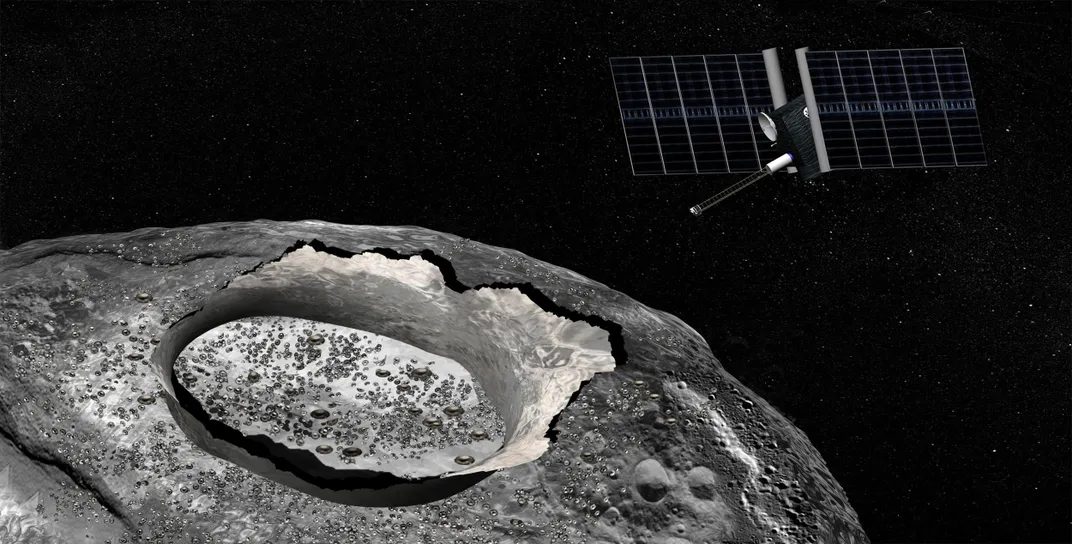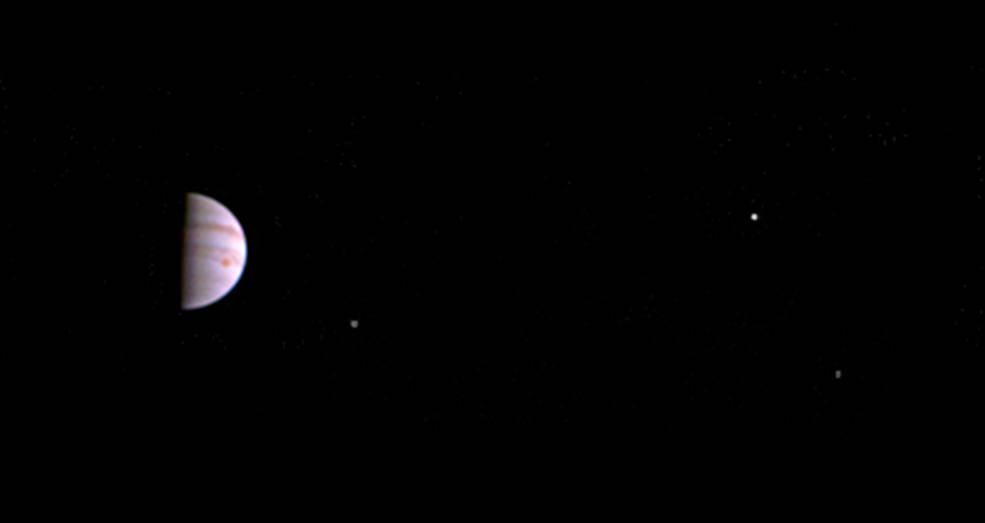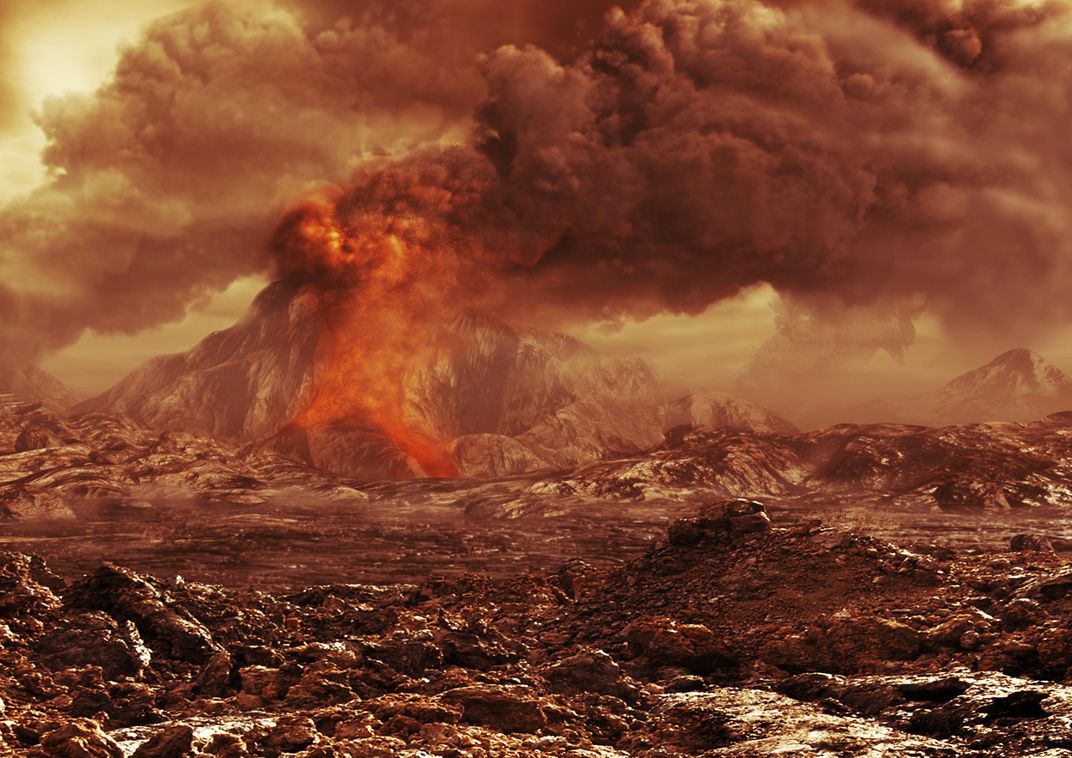To Uncover Earth’s Origins, Scientists Must Look Beyond It
Missions to study the other planetary bodies in our solar system could help solve the mystery of how our own came to be.
/https://tf-cmsv2-smithsonianmag-media.s3.amazonaws.com/filer/7e/59/7e593e43-c61b-4635-9fac-8a6cd1a36ed3/accretion-nature.jpg)
The great mysteries of the universe often revolve around distant, invisible phenomena. Scientists puzzle over inexplicable bursts of radio waves, the elusive nature of gravity and whether dark energy pervades the cosmos. But other enigmas can be found in our own corner of the galaxy, staring us right in the face—like how Earth became the planet it is today.
This question continues to fascinate researchers working to understand how Earth formed and why it’s so well suited to hosting life. It could have turned out differently—just look at our nearest neighbor and almost twin, Venus, which has no liquid water and whose surface is a sweltering 870 degrees Fahrenheit. “Venus and Earth are kind of the ultimate control case,” says Sue Smrekar of NASA’s Jet Propulsion Laboratory. “We don’t fully understand how Earth ended up so habitable and Venus so uninhabitable.”
That’s a bit surprising, given that Earth is by far the best-studied planet in the universe. But geologic processes like plate tectonics constantly recycle evidence of the past, and much of the critical information about Earth's makeup lies hidden in its vast, inaccessible depths. “You are trying to understand a planet that you can only sample at the surface,” says James Badro, a geophysicist at the Institute of Earth Physics in Paris. Although scientists have gleaned a wealth of knowledge from studying the ground beneath our feet, the full story of Earth’s construction and evolution remains unknown.
So researchers have turned to the skies for help. They have studied other star systems looking for clues, and searched for the building blocks of Earth among the detritus of the solar system. Now, a suite of planned and proposed space missions could help scientists fill in more of the missing pieces.
From studying new aspects of protoplanetary bodies to sleuthing out where they came from and how they got mixed together, researchers hope to pin down the processes of planetary formation that created Earth. For many, it’s as much a philosophical quest as a scientific one. “It’s a question of our origins,” Badro says.

Most researchers now agree on the general history of our solar system. It began 4.6 billion years ago, when a vast cloud of gas and dust floating in space collapsed onto itself, perhaps triggered by the shock wave of a nearby supernova. The flattened cloud then swirled into a spinning disk from which—about 100 million years later—our solar system emerged in more or less its current state: the sun surrounded by eight planets and innumerable smaller bodies scattered throughout.
The finer details of how our cosmic neighborhood formed, however, remain contentious. For instance, scientists still debate what the planets are made of. “We know what the cake looks like,” says Lindy Elkins-Tanton of Arizona State University, “but we would like to know what all those individual ingredients look like too,” she says.
Scientists think that the terrestrial planets grew by gobbling up smaller planetesimals—objects up to tens of miles in diameter that accumulated from protoplanetary dust. But the composition and structure of those planetesimals has been hard to determine. Studying our collection of meteorites—fragments of asteroids that have fallen to Earth—is a good place to start, says Francis Nimmo, a planetary scientist at the University of California, Santa Cruz. But it’s not enough.
That’s because we don’t necessarily have samples of everything that went into the planets—some components may be missing or may no longer exist at all. Some meteorites do appear to be a decent match for Earth, but scientists cannot come up with any combination of meteorite types that fully explains Earth’s chemical composition. “This is kind of uncomfortable because it means that we don’t really know how the Earth was put together,” Nimmo says.
Elkins-Tanton hopes that a proposed future mission—one of five finalists for NASA’s Discovery program—might be able to help. The project, led by Elkins-Tanton, would send an unmanned spacecraft to visit an object called Psyche, which sits in the asteroid belt between Mars and Jupiter. Psyche is roughly 150 miles wide and, based on remote observations of its density and surface composition, appears to be made of solid metal. It may also resemble the building blocks of Earth.
“This could be the little core of a body that was formed in the terrestrial planet-forming region and just got hit by a lot of other things and had its rocky exterior stripped away,” Elkins-Tanton says. On NASA’s Dawn mission, scientists studied the asteroid Vesta, a protoplanet that also probably formed near Earth and then got kicked out into the asteroid belt. However, it’s the unique opportunity to see what lies beneath the surface of objects like Vesta that has Elkins-Tanton excited.
“Psyche is the only body in the solar system that allows us to directly observe a metal core,” she says. “This could be our only chance of looking at this kind of ingredient.” Along with the other Discovery finalists, Elkins-Tanton and her colleagues will find out in September if the mission is a go.
According to the classical model of planetary formation, once planetesimals reached Psyche's size—tens to hundreds of miles across—they started to cannibalize their neighbors, says Kevin Walsh, a planetary scientist at the Southwest Research Institute in Boulder, Colorado. “The biggest ones grow really fast,” he says, thanks to their increasing gravitational influence.
This process of runaway accretion would have winnowed the number of bodies in the solar system to perhaps a hundred moon- to Mars-sized planetary embryos and a smattering of smaller debris. Over time, these embryos slowly combined to form planets.
But while this explanation works well for the terrestrial planets, which geologic evidence suggests formed over the course of 30 to 100 million years, it presents a problem for the gas giants like Jupiter. Scientists think the cores of these bodies had to grow much more quickly—fast enough to capture their massive atmospheres from the gas present in the early solar system, which dissipated in just a few million years.
Over the last decade, researchers have developed an alternative mechanism for growing planets known as pebble accretion. It represents a stark departure from the conventional model of accretion, in which objects combined to form progressively larger particles. Or, as Hal Levison, Walsh’s colleague, puts it: “Pebbles make boulders, and boulders make mountains—all the way up.” Pebble accretion, on the other hand, predicts that objects grow from fist-sized lumps to Pluto-sized bodies almost immediately, and then continue to gain mass, says Levison, who helped develop the hypothesis.
The process would have begun shortly after the formation of the protoplanetary disk, when bits of dust circling orbiting the young sun began to collide and stick together, like synchronized skaters joining hands while circling an ice rink. Eventually, aerodynamic and gravitational forces would have pulled large clusters of these pebbles together, forming planetesimals. The planetesimals then continued to sweep up the remaining pebbles around them, rapidly growing until they formed planets.
On top of addressing the question of how gas giants grew so fast, the model also provides a way to overcome something called the meter-size barrier, which has plagued models of planetary accretion since it was first outlined in the 1970s. It refers to the fact that once objects reach about three feet in diameter, friction generated by the surrounding gas would have sent them spiraling into the sun. Pebble accretion helps hurtle small particles over the threshold, making them big enough to hold their own.
Scientists are still trying to understand whether this process happened throughout the entire solar system, and whether it would have played out the same way for the inner and outer planets. (While it works for the gas giants, the later stages of rapid growth don’t fit with what we know about terrestrial planet formation). But researchers may find some clues later this year, when NASA’s Juno mission, which successfully reached Jupiter last month, begins gathering information about the planet’s composition and core.
Walsh says figuring out how much material lies at the center of the gas giant will help researchers constrain different models of planetary accretion. If Jupiter has a small core, classical accretion might have been able to build it up fast enough; if it’s big, it might imply that something like pebble accretion took place instead, he says.

Understanding how Jupiter formed will also help researchers understand the origins of the other planets, including Earth. That’s because Jupiter has been accused of meddling with the construction of the inner rocky planets, at least according to a new idea developed by Walsh and others that’s gained traction in recent years.
The hypothesis, known as the Grand Tack model, suggests that as Jupiter finished forming, it would have cleared out all the material in its path around the sun, effectively carving a gap in the protoplanetary disk. The disk, however, still contained plenty of gas and dust, which pressed in toward the sun as the disk flattened and stretched, Walsh says.
Jupiter’s gap effectively blocked the flow of this material, and the planet got “caught in the floodwaters,” Walsh says. It migrated in to about Mars’ orbit with Saturn close on its heels. But as Saturn followed, it trailed enough material to reconnect the disk. This released the pressure pushing on Jupiter, allowing both planets to migrate back out again, all in the space of a few hundred thousand years. The model was inspired by observations of oddly ordered planets in other solar systems that suggest such migrations are common, Walsh says.
For the rest of the solar system, this would have been something like a pair of bulls in a cosmic china shop. Bits of debris from the inner solar system would have gotten kicked out while clutter from the outer system would have gotten dragged in, Walsh says. The model helps explain Mars’ runt-size dimensions and the number and diversity of bodies found today in the asteroid belt.
It also provides a possible explanation for how the terrestrial planets got their water. According to Grand Tack, the gas planet migration would have taken place while the terrestrial planets were still forming, and could have tossed water-rich material from the outer solar system into the mix. Walsh and many other scientists think that carbonaceous asteroids, which may have formed beyond Jupiter, were the main vehicles for delivering water to Earth.
This September, NASA will launch a mission to visit one such asteroid named Bennu. Walsh is a co-investigator on the project, called OSIRIS-REx, which will study the body from afar before grabbing a sample to bring back to Earth. A similar mission by the Japanese space agency, called Hayabusa 2, is on track to sample another carbonaceous asteroid in 2018.
Scientists hope to learn more about where these asteroids came from, and whether they are indeed the source of a class of meteorites known as carbonaceous chondrites. They also hope that studying a pristine sample—rather than a meteorite fragment—will help reveal whether these objects delivered not only water to Earth, but the organic compounds that may have served as the precursors for life.
As OSIRIS-REx is returning to Earth, it could cross paths with Lucy, another proposed mission that, like Psyche, is a finalist in the Discovery program. Led by Levison, Lucy aims to explore the last major shake-up that rocked our solar system—a planetary tango that began about 500 million years after the Grand Tack. That’s when, according to a hypothesis by Levison and others, Pluto triggered an instability that caused Neptune to hopscotch outside of Uranus and the outer gas giants to migrate away from the sun to their present positions.
This disturbance, known as the Nice model, would have sent a rain of debris hurtling into the inner solar system, possibly explaining a cluster of impacts formed during a period known as the Late Heavy Bombardment. The terrestrial planets, like Earth, had mostly formed by this point, so the event didn’t significantly affect their composition. But it may have thrown a curveball at scientists trying to understand how the solar system evolved. The disruption might have flung objects into the inner solar system that had no connection to the materials that make up the bulk of the terrestrial planets, Walsh says.
Lucy could help scientists figure out what really happened and allow them to disentangle what got mixed where. It would accomplish this by investigating a group of asteroids locked into Jupiter’s orbit. These objects, known as the Jovian Trojans, are a mixture of bodies that formed throughout the outer solar system and then got thrown together during the migration.
In the mid-2020s, when the mission would reach them, the Trojans will be oriented in just the right configuration for a spacecraft to make a grand tour of six bodies. “I’ve been worshipping the celestial mechanics gods for my whole career,” says Levison, a planetary dynamicist. “They decided to pay me back, because the planets are literally aligning.”
Levison says studying the Trojans up close will give researchers a clearer idea of how the Nice model mixing occurred, and could also provide a test of pebble accretion. The hypothesis predicts that anything smaller than about 60 miles across should actually be a fragment of a larger body. It's a prediction Lucy should be able to test.

Together, these missions appear poised to further scientists’ understanding of Earth’s origins, probably in ways researchers can’t even imagine yet. After all, building a robust picture of planetary formation requires combining data from many different sources, says David Stevenson, a planetary scientist at Caltech.
However, we still have a long way to go before we understand what makes the Earth and Venus so different. “It’s an embarrassment, almost, that here we are, sitting on Earth, and we’ve got this big nearest planet to us that we’re so ignorant about,” Stevenson says. “The reason we’re so ignorant is it’s damn hot!”
Indeed, the hellish conditions on Venus’s surface have stymied efforts to study the planet in detail. Russia managed to land a series of spacecraft on the surface between the 1960s and 80s. They only survived for a few hours and transmitted brief flashes of data before succumbing to the heat. But these and other missions, like NASA’s Pioneer and Magellan, which studied the planet from afar, did provide glimpses into the planet’s workings.
We know, for instance, that Venus has an intense greenhouse atmosphere made almost entirely of carbon dioxide and that it seems to have lost most of its surface water. This may be what prevents plate tectonics from occurring there — water is thought to grease the wheels of subducting plates. It may also explain why Venus lacks a geomagnetic field, which many scientists consider a necessity for life because it shields the planet from the ravages of the solar wind. Geomagnetic fields are produced by convection in the core of a body, Nimmo says, and rely on mantle circulation — often tied to plate tectonics — to transport heat away.
What scientists want more than anything are samples of Venus’ surface rocks, but that remains a distant goal. For the foreseeable future, researchers will have to settle for more remote observations, like those from a current Japanese mission. Earlier this year, the Akatsuki spacecraft finally began relaying data from its orbit around Venus after an unplanned five-year detour around the sun.
In addition, NASA is considering two more Venus-centered missions of its own that are also Discovery finalists. One project, called VERITAS, is led by Smrekar and would involve an orbiter capable of studying the planet’s geology in high definition. The second proposed mission, led by Lori Glaze of the Goddard Space Flight Center, would analyze Venus’ unique atmosphere using a probe called DAVINCI.
The hope is that these efforts will reveal why Venus evolved the way it did, and thus, what makes Earth different. At the moment, many researchers think Earth and Venus probably formed from roughly the same material then diverged over time thanks to several factors. These include their differing proximity to the sun, and the fact that Earth experienced a major collision relatively late in its history—the impact that formed the moon—which would have re-melted much of the planet and potentially altered its dynamics.
But until we know more about how the planets in our solar system formed and what processes shaped their evolution, we won’t know what differentiates a hospitable planet from a barren one, Walsh says. “We have telescopes in space that are hunting Earth-sized planets around other stars, but we have no clue if a planet will evolve into a Venus or into an Earth,” he says. “And that’s the whole ball game, at some level.”